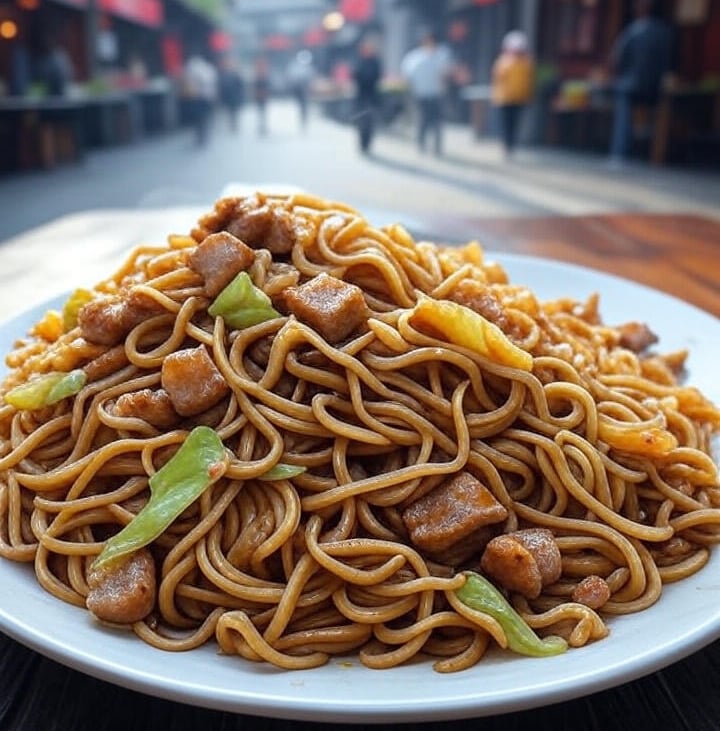Welcome to Noodles of Asia ! - A Woke Noodle Blog
Celebrating Rice Stick Noodles: A Journey Through Asia’s Thin Delight


Hey there, noodle lovers! If you’ve ever savored a plate of thick, chewy noodles tossed in a rich, savory sauce, you might have encountered Shanghai noodles. These wheat-based delights, known for their springy texture and ability to soak up bold flavors, are a cornerstone of Shanghai’s vibrant food scene. Whether stir-fried with pork and cabbage or served in a hearty broth, Shanghai noodles are all about comfort and versatility. In this post, we’ll explore their origins, history, fascinating facts, and a few iconic recipes to spark your next kitchen adventure. Let’s get started!
Origins and History of Shanghai Noodles
Shanghai noodles, often called "cu mian" (thick noodles) in Chinese, trace their roots to the bustling culinary hub of Shanghai, China. Emerging during the Qing Dynasty (1644–1912), these wheat flour noodles became a staple in the Yangtze River Delta region, where Shanghai’s unique blend of culinary influences took shape. By the 19th century, street vendors and teahouses popularized stir-fried noodle dishes, blending local ingredients with techniques from neighboring provinces. The noodles’ heartiness made them a favorite among workers, and their global spread in the 20th century came with Chinese immigration, introducing Shanghai noodles to Chinatowns worldwide.
Interesting Facts About Shanghai Noodles
Shanghai noodles aren’t just a meal—they’re a cultural icon! Here are some tasty tidbits:
Texture is King: Shanghai noodles are thicker and chewier than many other Chinese noodles, making them perfect for soaking up rich sauces in stir-fries.
Street Food Star: In Shanghai, street stalls serve these noodles with everything from soy sauce and pork to spicy chili oil, showcasing their versatility.
Handmade Tradition: Traditional Shanghai noodles are hand-pulled or cut, giving them an irregular, rustic texture that enhances their appeal.
Global Reach: From New York’s Chinatown to Sydney’s food courts, Shanghai noodles have become a beloved dish in Chinese restaurants worldwide.
Cultural Fusion: In modern cuisine, chefs pair Shanghai noodles with non-traditional ingredients like mushrooms or Western-style sauces for creative twists.
These facts showcase why Shanghai noodles remain a beloved staple, from street carts to fine dining.
Famous Shanghai Noodle Recipes
Shanghai noodles shine in a variety of dishes, from classic stir-fries to comforting soups. Below are some iconic recipes to inspire you. (Note: These are brief overviews—adjust to taste and check detailed recipes online for specifics.)
Shanghai Fried Noodles: Thick noodles stir-fried with pork, cabbage, and a savory soy-based sauce—a classic that’s simple yet satisfying.
Spicy Beef Noodle Soup: Shanghai noodles in a rich, spicy beef broth with tender meat and greens—a warming winter favorite.
Shanghai Scallion Oil Noodles: Noodles tossed in a fragrant mix of scallion-infused oil and soy sauce—a minimalist dish with bold flavor.
Seafood Shanghai Noodles: Stir-fried noodles with shrimp, scallops, and veggies in a light oyster sauce—a coastal twist.
Vegetarian Shanghai Noodles: Noodles with shiitake mushrooms, bok choy, and a touch of sesame oil—a plant-based delight.
Cold Shanghai Noodle Salad: Chilled noodles with cucumber, chili oil, and peanuts—a refreshing summer dish.
For a fun challenge, try hand-pulling your own Shanghai noodles: Knead wheat flour dough, stretch into strands, and boil—or grab pre-made noodles for ease.
Wrapping It Up
Shanghai noodles are more than just a dish—they’re a taste of Shanghai’s rich culinary heritage, bridging traditional Chinese flavors with modern global palates. Whether you’re tossing them in a quick stir-fry or simmering them in a soul-warming broth, these noodles deliver comfort and flavor in every bite. Next time you’re at a Chinese restaurant or experimenting in your kitchen, give a Shanghai noodle dish a whirl. What’s your favorite way to enjoy Shanghai noodles? Drop a comment below—I’d love to hear! Until next time, happy eating! 🍜
